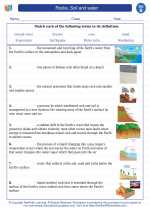Topic: Air
Air is all around us, but what exactly is it? Let's explore this fascinating topic together!
What is Air?
Air is a mixture of gases that makes up the Earth's atmosphere. The most abundant gases in air are nitrogen (about 78%) and oxygen (about 21%). The remaining 1% is made up of other gases such as carbon dioxide, argon, and water vapor.
Properties of Air
Air has several important properties:
- Invisible: We cannot see air, but we can feel its effects as it moves things around.
- Weighs Something: Even though we can't see it, air has mass and takes up space.
- Can be Compressed: Air can be squeezed into a smaller space, and when released, it expands to fill its container.
- Exerts Pressure: The weight of the air above us creates air pressure.
- Supports Combustion: Oxygen in the air is necessary for combustion, or burning, to occur.
Importance of Air
Air is essential for life on Earth. Plants and animals need oxygen from the air to survive, and the carbon dioxide they produce is released back into the air. Air also helps regulate the Earth's temperature and transports water vapor, leading to weather patterns and precipitation.
How to Study Air
To study air, you can conduct simple experiments to observe its properties. For example, you can use a balloon to demonstrate that air takes up space and exerts pressure. You can also explore the effects of air pressure by using a suction cup or a syringe. Additionally, you can investigate the role of air in supporting combustion by conducting safe and supervised experiments with candles or matches.
It's also important to learn about air quality and pollution, as human activities can impact the composition of the air we breathe. Understanding the importance of clean air and how to reduce air pollution is crucial for the health of our planet and all living things.
Exploring the topic of air can be a fun and enlightening experience, leading to a deeper appreciation for the invisible but vital substance that surrounds us every day!
[Air] Related Worksheets and Study Guides:
.◂Science Worksheets and Study Guides Second Grade. Rocks, Soil and water

 Worksheet/Answer key
Worksheet/Answer key
 Worksheet/Answer key
Worksheet/Answer key
 Worksheet/Answer key
Worksheet/Answer key
 Vocabulary/Answer key
Vocabulary/Answer key
 Vocabulary/Answer key
Vocabulary/Answer key
